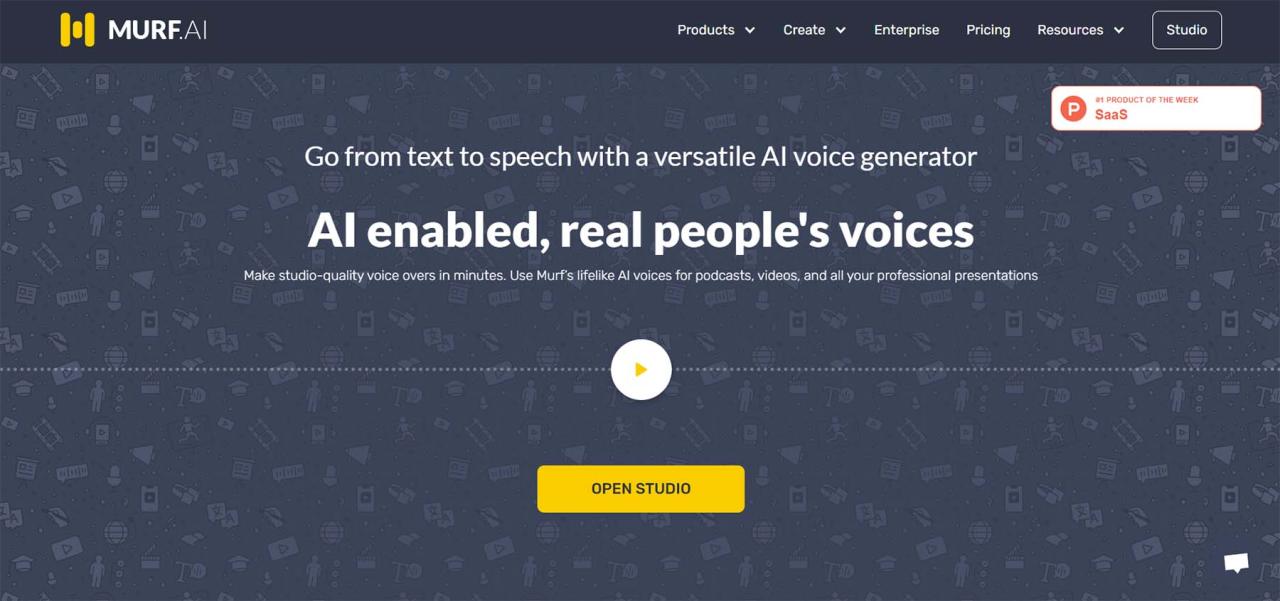Best AI voice generator for realistic human voices is revolutionizing how we interact with technology. From lifelike customer service interactions to immersive audiobooks, the ability to generate convincingly human-sounding voices is transforming industries. This guide explores the technology behind these impressive tools, delving into the factors that contribute to realism, comparing top platforms, and examining the ethical considerations and future trends of this rapidly evolving field.
We’ll cover the technical aspects, customization options, and diverse applications of AI voice generation, providing a comprehensive overview for both beginners and those already familiar with the technology. Understanding the nuances of AI voice generation will empower you to make informed decisions about its use and potential impact.
Finding the best AI voice generator for realistic human voices can be tricky, but it’s worth the effort for creating engaging content. Think about how much smoother a podcast or audiobook would sound with a truly lifelike voice. For example, imagine the impact if Gloria Hunniford’s powerful message in Loose Women’s Gloria Hunniford shares how stark doctor’s warning was delivered using one of these advanced AI tools.
The right AI voice generator can make your projects stand out, offering a level of professionalism that’s hard to match.
AI Voice Generators: A Deep Dive into Realistic Human Voices
The ability to generate realistic human voices using artificial intelligence is rapidly transforming various industries. This technology, once a futuristic fantasy, is now a powerful tool with applications ranging from virtual assistants to audiobooks and beyond. This article explores the technology behind AI voice generators, examines leading platforms, and discusses the ethical considerations and future trends of this exciting field.
Introduction to AI Voice Generators
AI voice generation leverages sophisticated algorithms, primarily deep learning models, to synthesize human-like speech. These models are trained on vast datasets of human speech, learning to mimic the nuances of pronunciation, intonation, and rhythm. The evolution of this technology has seen significant milestones, from early text-to-speech systems with robotic-sounding voices to today’s highly realistic and expressive outputs.
Different types of AI voice generators exist, including concatenative synthesis, which stitches together pre-recorded speech segments, and parametric synthesis, which generates speech waveforms directly from parameters. Parametric methods, particularly those using neural networks, are currently leading the way in achieving higher realism and flexibility.
Factors Determining Realism in AI Voices
Creating truly realistic AI voices requires attention to several crucial factors. Naturalness hinges on accurate pronunciation, appropriate intonation and pacing, and the subtle variations in tone that characterize human speech. Natural Language Processing (NLP) plays a vital role in ensuring that the generated speech is contextually relevant and grammatically correct, adding to the overall realism.
Advanced audio processing techniques, such as noise reduction and spectral shaping, significantly improve the quality of the synthesized voice. The choice of synthesis method also impacts realism; neural vocoders, for instance, often produce superior results compared to traditional methods.
Top AI Voice Generator Platforms

Several leading platforms offer AI voice generation capabilities. The choice of platform depends on factors such as budget, desired features, and target audience.
| Platform Name | Key Features | Pricing | Pros and Cons |
|---|---|---|---|
| Platform A | High-quality voices, extensive language support, API access | Subscription-based, tiered pricing | Pros: Excellent voice quality, versatile features. Cons: Can be expensive, limited free tier. |
| Platform B | User-friendly interface, customizable voices, text-to-speech conversion | Freemium model, credits-based system | Pros: Easy to use, affordable for small projects. Cons: Limited voice options in free tier, potential for lower quality at lower tiers. |
| Platform C | Focus on natural language processing, emotional expression, advanced customization | Custom pricing, enterprise solutions | Pros: Highly realistic voices, sophisticated features. Cons: Expensive, may require technical expertise. |
| Platform D | Wide range of voices, multiple languages, strong API integration | Pay-as-you-go, competitive pricing | Pros: Cost-effective, scalable solutions. Cons: Voice quality might not match the top tier platforms. |
Voice Customization and Personalization Options, Best AI voice generator for realistic human voices
Many platforms offer robust customization options. Users can fine-tune aspects like tone, pitch, and accent to create unique voices. This often involves adjusting parameters within the platform’s interface or, in more advanced cases, providing custom training data to create a truly personalized AI voice. Techniques for achieving emotional expression include manipulating intonation, rhythm, and pauses to convey different moods and feelings.
Applications of Realistic AI Voices

Realistic AI voices are revolutionizing numerous industries. In customer service, they power chatbots and virtual assistants; in media, they narrate audiobooks and create voiceovers; in education, they provide personalized learning experiences. However, ethical considerations arise regarding potential misuse, such as creating deepfakes or spreading misinformation.
Future applications could include personalized news broadcasts, immersive gaming experiences, and advanced assistive technologies for individuals with disabilities.
Technical Aspects and Limitations

High-quality AI voice generation requires significant computational resources, particularly for training complex deep learning models. Current limitations include occasional unnatural pauses or inflections, difficulty in generating voices with strong regional accents, and challenges in handling complex linguistic structures.
Generating voices in multiple languages presents further challenges due to variations in phonetics, intonation, and linguistic rules.
Future Trends in AI Voice Generation
Future advancements are likely to focus on improving naturalness and expressiveness. Researchers are exploring methods to incorporate emotional intelligence, enabling AI voices to convey a wider range of emotions more convincingly. Real-time voice generation with reduced latency is another key area of development.
- Improved multilingual support
- Enhanced emotional expression
- Integration with other AI technologies, such as facial animation
Illustrative Examples of Realistic AI Voices
Consider three hypothetical examples: Voice A, a warm and friendly female voice ideal for customer service interactions; Voice B, a sophisticated and authoritative male voice suitable for corporate presentations; and Voice C, a youthful and energetic voice perfect for educational content.
Voice A’s applications include interactive voice response systems and personalized shopping assistants. Voice B could be used for automated reports and company announcements. Voice C might power interactive learning platforms and engaging children’s stories.
Finding the best AI voice generator for realistic human voices can be tricky, but it’s worth the effort for creating engaging content. Think about using one to narrate a sports recap, like this amazing match: Milan 2-1 Juventus (Jan 3, 2025) Game Analysis – ESPN. Imagine the commentary! The right AI voice could make your sports analysis videos really stand out, boosting your audience engagement.
So, keep exploring those AI voice options.
Final Conclusion: Best AI Voice Generator For Realistic Human Voices

As AI voice generation technology continues its rapid advancement, the line between human and artificial voices blurs ever more. We’ve explored the key factors contributing to realism, examined leading platforms, and discussed the ethical implications and future possibilities. By understanding the capabilities and limitations of these tools, we can harness their potential responsibly while anticipating the exciting developments yet to come in this dynamic field.
Choosing the best AI voice generator will depend on your specific needs and budget, but armed with this knowledge, you’re well-equipped to make an informed decision.
Want a super realistic AI voice? Check out the top contenders for generating human-like speech; you’ll be amazed! But hey, while you’re exploring tech, did you see that PULISIC IS THE MVP FROM JUVENTUS v AC MILAN ? Back to those AI voices – some even mimic specific accents, making them perfect for diverse projects.
FAQ Overview
What are the ethical concerns surrounding AI voice generation?
Ethical concerns include potential misuse for creating deepfakes, impersonating individuals without consent, and the spread of misinformation through realistic synthetic voices.
How much does it cost to use an AI voice generator?
Pricing varies widely depending on the platform and usage. Some offer free tiers with limitations, while others charge per minute or offer subscription plans.
Can I use AI-generated voices for commercial purposes?
Check the license agreement of your chosen platform. Many allow commercial use, but some may have restrictions or require additional fees.
What kind of hardware do I need to use an AI voice generator?
Most platforms are accessible through web browsers, requiring only a decent internet connection. For advanced features or offline use, more powerful hardware might be necessary.
